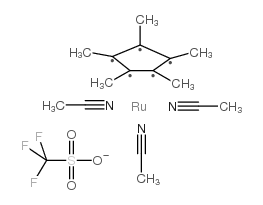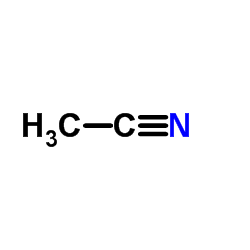113860-02-9
| Name | acetonitrile,1,2,3,4,5-pentamethylcyclopentane,ruthenium,trifluoromethanesulfonate |
|---|
| Molecular Formula | C17H24F3N3O3RuS- |
|---|---|
| Molecular Weight | 508.52100 |
| Exact Mass | 509.05300 |
| PSA | 136.95000 |
| LogP | 5.69384 |
| Storage condition | 2-8℃ |
|
Section 1: Product Identification Chemical Name:Tris(acetonitrile)pentamethylcyclopentadienylruthenium (II) trifluoromethanesulfonate, min. 98% CAS Registry Number:113860-02-9 Formula:[Ru(C10H15)(CH3CN)3]+CF3SO3- EINECS Number:none Chemical Family:organometallic complex Synonym:pentamethylcyclopentadienyl-tris(acetonitrile)ruthenium (II) trifluoromethanesulfonate
Section 2: Composition and Information on Ingredients IngredientCAS NumberPercentACGIH (TWA)OSHA (PEL) Title compound113860-02-9100%no datano data Section 3: Hazards Identification Emergency Overview:Irritating to the respiratory tract, skin and eyes. May be harmful if swallowed. Primary Routes of Exposure:Ingestion, inhalation, skin, eyes Eye Contact:Causes irritation of the eyes. Skin Contact:Causes irritation of the skin. Inhalation:Dust is irritating to the nose, mucous membranes and respiratory tract. Ingestion:No specific information is available on the physiological effects of ingestion. May be harmful if swallowed. Acute Health Affects:Irritating to skin, eyes and respiratory tract. May be harmful if swallowed. Chronic Health Affects:No information on long-term chronic effects. NTP:No IARC:No OSHA:No SECTION 4: First Aid Measures Immediately flush the eyes with copious amounts of water for at least 10-15 minutes. A victim may need Eye Exposure: assistance in keeping their eye lids open. Get immediate medical attention. Wash the affected area with water. Remove contaminated clothes if necessary. Seek medical assistance if Skin Exposure: irritation persists. Remove the victim to fresh air. Closely monitor the victim for signs of respiratory problems, such as difficulty Inhalation: in breathing, coughing, wheezing, or pain. In such cases seek immediate medical assistance. Seek medical attention immediately. Keep the victim calm. Give the victim water (only if conscious). Induce Ingestion: vomiting only if directed by medical personnel. SECTION 5: Fire Fighting Measures Flash Point:none Autoignition Temperature:none Explosion Limits:none Extinguishing Medium:carbon dioxide, dry powder or foam If involved in a fire, fire fighters should be equipped with a NIOSH approved positive pressure self-contained Special Fire Fighting Procedures: breathing apparatus and full protective clothing. Hazardous Combustion andIf involved in a fire, this material may emit toxic fumes. Decomposion Products: Unusual Fire or Explosion Hazards: No unusual fire or explosion hazards. SECTION 6: Accidental Release Measures Spill and Leak Procedures:Small spills can be mixed with vermiculite or sodium carbonate and swept up. SECTION 7: Handling and Storage The material will degrade on prolonged exposure to air. Store cold. Handle under an inert atmosphere of Handling and Storage: nitrogen or argon. Keep bottle tightly sealed and away from heat and direct sunlight. SECTION 8: Exposure Controls and Personal Protection Eye Protection:Always wear approved safety glasses when handling a chemical substance in the laboratory. Skin Protection:Wear protective clothing and gloves. Ventilation:Handle the material in an efficient fume hood. If ventilation is not available a respirator should be worn. The use of respirators requires a Respirator Respirator: Protection Program to be in compliance with 29 CFR 1910.134. Ventilation:Handle the material in an efficient fume hood. Additional Protection:No additional protection required. SECTION 9: Physical and Chemical Properties Color and Form:orange powder Molecular Weight:508.52 Melting Point:no data Boiling Point:no data Vapor Pressure:no data Specific Gravity:no data Odor:not determined Solubility in Water:hygroscopic SECTION 10: Stability and Reactivity Stability:air sensitive (store cold) Hazardous Polymerization:no hazardous polymerization Conditions to Avoid:Contact with air. This material may degrade on prolonged exposure to air and moisture. Incompatibility:oxidizing agents, halogens and active metals. Decomposition Products:carbon monoxide, carbon dioxide, organic fumes, phosphorous pentoxide and ruthenium oxide. SECTION 11: Toxicological Information RTECS Data:No information available in the RTECS files. Carcinogenic Effects:No data Mutagenic Effects:No data Tetratogenic Effects:No data SECTION 12: Ecological Information Ecological Information:No information available SECTION 13: Disposal Considerations Disposal:Dispose of according to local, state and federal regulations. SECTION 14: Transportation Shipping Name (CFR):Non-hazardous Hazard Class (CFR):NA Additional Hazard Class (CFR):NA Packaging Group (CFR):NA UN ID Number (CFR):NA Shipping Name (IATA):Non-hazardous Hazard Class (IATA):NA Additional Hazard Class (IATA):NA Packaging Group (IATA):NA UN ID Number (IATA):NA SECTION 15: Regulatory Information TSCA:Not listed in the TSCA inventory SARA (Title 313):Title compound not listed Second Ingredient:none SECTION 16 - ADDITIONAL INFORMATION N/A |
|
~93% 
113860-02-9 |
| Literature: Fagan, Paul J.; Ward, Michael D.; Caspar, Jonathan V.; Calabrese, Joseph C.; Krusic, Paul J. Journal of the American Chemical Society, 1988 , vol. 110, p. 2981 - 2983 |
|
~96% 
113860-02-9 |
| Literature: Fagan, Paul J.; Ward, Michael D.; Calabrese, Joseph C. Journal of the American Chemical Society, 1989 , vol. 111, # 5 p. 1698 - 1719 |
| Precursor 3 | |
|---|---|
| DownStream 0 | |


